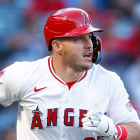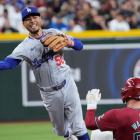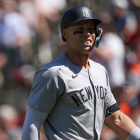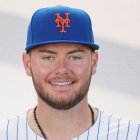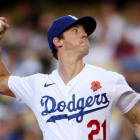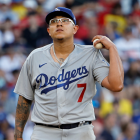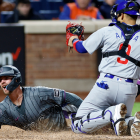For the first time since trading away Hall of Famer Rickey Henderson in 1989, the New York Yankees became sellers last summer. They traded Aroldis Chapman, Andrew Miller, Carlos Beltran, and Ivan Nova in separate deadline deals that netted them 12 total prospects. The selling continued in the offseason as Brian McCann was traded for two more prospects. As a result, New York has one of the game’s best and deepest farm systems.
The Yankees called up several of their top prospects following the trades last year, most notably Gary Sanchez, who went on a two-month rampage against American League pitching. That earned him a second-place finish in the AL Rookie of the Year voting despite playing only one-third of the season. Other youngsters were called up too, and several more figure to be given an opportunity this coming season.
Trading productive veterans for prospects and giving prospects playing time in the second half are the actions of a rebuilding team, though the Yankees refuse to admit they’re rebuilding. They prefer to be called a team in transition.
Here’s what general manager Brian Cashman told Mike Mazzeo of the New York Daily News last month:
“We’re in transition,” Brian Cashman said Thursday. “But we’re not waving the white flag while transitioning.”
Translation: the Yankees are trying to get younger and remain competitive at the same time. A full blown Astros-style tear down rebuild won’t happen. That’s why the Yankees signed Chapman to the largest reliever contract in history over the winter, added a $13 million designated hitter in Matt Holliday, and pounced when Chris Carter was still available in February.
Getting younger while staying competitive is a fine goal, though it’s not easy. Young players come with growing pains, even the most talented players, and the Yankees no longer have the veteran star power to pick up the slack. Beltran is gone, McCann is gone, Mark Teixeira is gone, and Alex Rodriguez is gone. They’re all-in on the kids.
If spring training is any indication, the young players are ready to go. The Yankees are 22-8 this spring and have baseball’s best record, and they rank fourth among all teams in home runs (45) and third among all teams in ERA (3.69). Those numbers won’t mean anything once the regular season starts, but, if nothing else, it gives fans some hope for the future as the Yankees try to develop their next championship core.
Let’s preview their 2017 season, shall we?
The vitals
- 2016 record: 84-78
- 2017 depth chart: Click here
- 2017 schedule: Click here
Gary Sanchez’s sophomore season
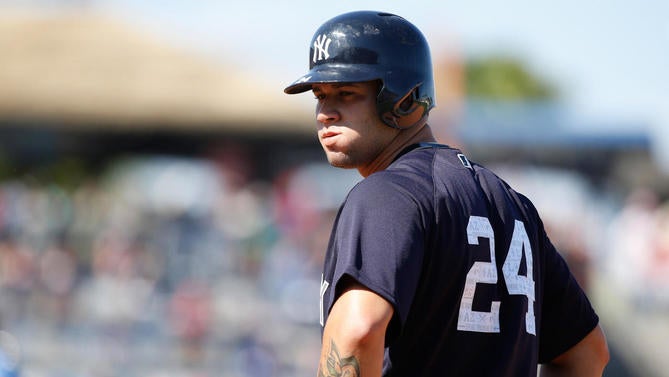
Let’s start with the obvious: no, Sanchez won’t do that again. What he did last season after being called up in August was both incredible and unsustainable. He hit .299/.376/.657 (168 OPS+) with 20 home runs in 53 games last season -- he reached 20 home runs faster than anyone in history, getting there in his 51st career game -- and expecting that across a full 162-game season with the general wear and tear of catching is unrealistic.
That said, Sanchez’s bat is legit and he should be a force in the middle of New York’s lineup. The kid wasn’t a five-time top-100 prospect per Baseball America for nothing. His power combined with hitter-friendly Yankee Stadium (as well as the other hitter friendly AL East parks) give Sanchez a chance to become the first full-time catcher to hit 30-plus home runs in a season since Javy Lopez swatted 43 for the 2003 Braves.
What would qualify as a successful season for Sanchez? That’s difficult to answer, not only because he set the bar so high last season, but also because young catchers are known to have a fairly long adjustment period given all the defensive responsibilities. For what it’s worth, ZiPS projects Sanchez to hit .255/.313/.490 (120 OPS+) with 27 home runs in 2017, and if he does that, he’ll be one of the most productive catchers in baseball.
At the same time, that’s a pretty big step down from what Sanchez did last year. Going from 20 homers in 53 games to 27 homers in a full 162 games is going to have folks wondering what happened. Where’d the huge power go? Was it a fluke? Well, yeah, kind of. Exactly 40 percent of Sanchez’s fly balls left the park last year, which is insane. The league average was 12.8 percent. There have been 716 individual seasons by hitters with enough plate appearances to qualify for the batting title the last five years, and only 19 had a 25.0-plus HR/FB%. Only one cleared 30.0 percent: 2015 Nelson Cruz (30.3 percent).
Point is, Sanchez figures to still be a very productive player this season, especially relative to his position. It’s just unlikely he’ll be as great was he was last year across the full season. Maybe I’m wrong and Sanchez is an outlier a la Mike Piazza or Mike Trout. Special talents have a way of doing things no one expects. It just seems expecting a just turned 24-year-old catcher to repeat that level of production over the long haul is setting yourself up for disappointment.
Which young players will emerge in 2017?
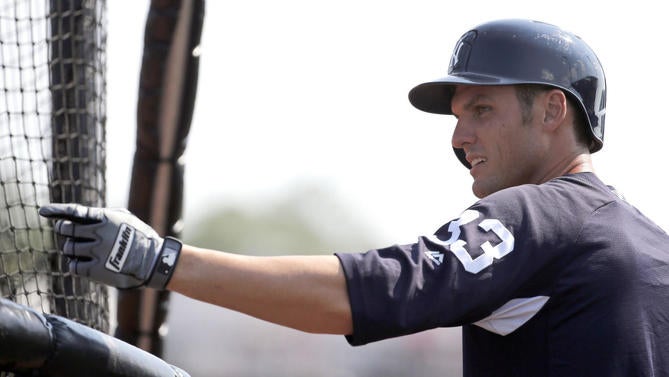
Sanchez is entrenched behind the plate. If there were any doubts about that going into the offseason, they were erased when the Yankees traded McCann. Sanchez is the man behind the plate. The Yankees will have several other young players assume full-time roles this season, plus plenty of others could get a chance later in the season. Here’s a position-by-position breakdownt:
First Base: Last week manager Joe Girardi announced Greg Bird, who missed all of last season with shoulder surgery, will be the team’s everyday first baseman. He’s torn the cover off the ball this spring and was going to be a big part of the offense last year by sharing time with Teixeira and A-Rod, but the shoulder injury threw a wrench into that. Bird is a former top-100 prospect and the kind of left-handed power bat who thrives in Yankee Stadium. The plan this year is to have Bird join Sanchez and Holliday in the 3-4-5 lineup spots, in whatever order.
Middle Infield: The recent injury to Didi Gregorius has created an opening at shortstop for the first several weeks of the season, though that spot will not be filled by top prospect Gleyber Torres. The 20-year-old wunderkind, whom MLB.com recently ranked as the third-best prospect in baseball, was reassigned to minor-league camp last week, and will begin the season in Double-A. I don’t think it’s out of the question Torres goes from Double-A to MLB in his age-20 season the same way Xander Bogaerts did in 2013 and Carlos Correa did in 2015, however. We could see him in the Bronx in the second half.
More likely, the Gregorius injury created an opening for shortstop Tyler Wade, who spent last year in Double-A and is a quality prospect himself, though not a Torres-caliber prospect. The Yankees had Wade learn the outfield in the Arizona Fall League last year in an effort to turn him into a Ben Zobrist-esque utility man, but that plan could be put on hold so he can play shortstop while Gregorius it out. Either way, Wade figures to make his MLB debut at some point in 2017.
Outfield: The massive Aaron Judge -- he’s listed at 6-foot-7 and 275 lbs. -- made his MLB debut last August and took over as the everyday right fielder following the Beltran trade, and he’s poised to hold down the position this season as well. (The Yankees insist Aaron Hicks is also a candidate for the right field job.) Judge has massive raw power ...
... and he’s a better pure hitter than he gets credit for, but his size is an obstacle. He has a lot of strike zone to cover, and big-league pitchers exploited that during his MLB cameo last season. (Judge struck out 42 times in 95 plate appearances. Yeah.) He’s been working to find a more compact stroke for years now, and while strikeouts always figure to be part of his game, the Yankees will live with them as long as Judge keeps hitting the ball a mile when he connects.
Along with Judge, the Yankees also have a top outfield prospect in Clint Frazier, who came over from the Indians in the Miller trade and will open the season in Triple-A. MLB.com recently ranked him as the No. 24 prospect in baseball. The Yankees looked to trade Brett Gardner all offseason in an effort to open a roster spot for Frazier, though for now Gardner remains, and Frazier will have a chance to finish off his development in Triple-A. When the Yankees deem him ready, they’ll call him up and make room somehow. Other outfield prospects like Dustin Fowler and Billy McKinney could see MLB time in 2017 as well.
Rotation: This is where it gets complicated. The Yankees have three veteran starters to front the rotation (Masahiro Tanaka, CC Sabathia, Michael Pineda), but rather than pick up a veteran innings eater or two over the winter, they’ve opted to roll the dice with their young arms. Luis Severino, Luis Cessa, Bryan Mitchell, and Chad Green all came into camp as rotation candidates -- Cessa has already been reassigned to minor-league camp, so he’s out of the big league mix -- while young lefty Jordan Montgomery has pitched his way into Opening Day roster consideration.
No team makes it through a season using only five starters these days, so whoever the Yankees decline to take north as the fourth and fifth starters won’t necessarily sit in Triple-A all year. The other young guys will get a chance at some point. The Yankees have no established starters under contract behind 2017 -- Sabathia and Pineda will be free agents after the season, and Tanaka will be able to opt-out of his contract -- so they’re hoping at least one of those young guys emerges as a reliable long-term starter this summer.
Down in the minors, the Yankees have discussed the possibility of top pitching James Kaprielian making his MLB debut late in the season, though he missed most of 2016 with an elbow injury, and the team will play it safe with him this year. Fellow top pitching prospects Justus Sheffield (Miller trade) and Albert Abreu (McCann trade) figure to spend the season in the minors. (MLB.com ranks Kaprielian and Sheffield as the Nos. 58 and 79 prospects in baseball, respectively.) Secondary pitching prospects like Montgomery and righty Chance Adams are more MLB possibilities this year. Severino, Cessa, Green, and Mitchell are the front line. They’ll get the first chance to help the Yankees.
Bullpen: These days every starting pitcher prospect should be considered a potential bullpen option as well. Severino, Cessa, and Mitchell have all had lengthy stints in New York’s bullpen, and it’s possible Montgomery will make the Opening Day roster as a reliever as well. The Yankees have two solid relief prospects in Ben Heller (Miller trade) and Jonathan Holder, both of whom made their MLB debut last season and will get another look this year. New York has a great farm system, but not because they’re deep in relievers. They’re just hoping to develop one or two cheap middle innings options, and given the way things go these days, plenty of guys will get an opportunity in 2017.
Masahiro Tanaka’s looming opt-out
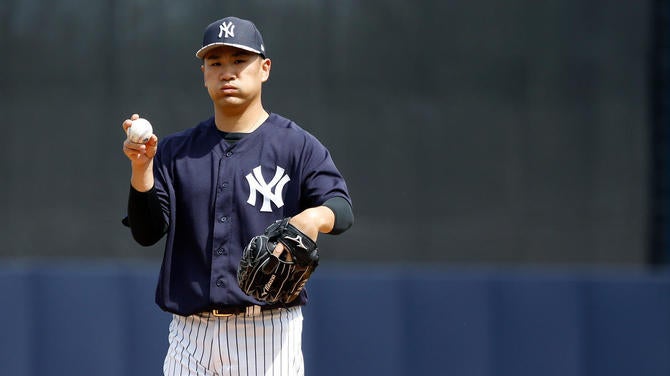
Three years ago it seemed Tanaka would need Tommy John surgery following a midseason elbow injury, but he was able to successfully rehab the elbow, and he’s had no issues since. Last season the 28-year-old right-hander finished third in the AL with a 3.07 ERA, fifth with a 1.08 WHIP, and third with 5.4 WAR. He fell one out short of reaching 200 innings. Simply put, Tanaka was one of the best pitchers in the league, and was recognized as such given his seventh-place finish in the Cy Young voting.
After the 2017 season Tanaka will be able to opt out of the final three years and $67 million remaining on his contract, and if he stays healthy and repeats his 2016 effort, he will certainly do that, even with lingering concerns about his elbow. Remember, Jeff Samardzija landed a five-year contract worth $95 million last year after leading the league in hits, home runs, and earned runs allowed. Tanaka would have little trouble exceeding that $67 million guarantee.
The opt-out puts the Yankees in a tough place. On one hand, Tanaka is an excellent pitcher in his prime years and they’d like to keep him because he can speed up the rebuild transition. On the other hand, his elbow remains a lingering concern, plus the Yankees want to get under the luxury tax threshold fairly soon. Re-signing Tanaka means assuming a lot of injury risk and also making it difficult to get under the luxury tax threshold in the near future.
Keep in mind the new collective bargaining agreement changed the qualified free agent rules. Because the Yankees will pay luxury tax in 2017, the best compensation draft pick they can get for Tanaka is a pick after the fourth round. That’s nothing. It’ll be interesting to see whether the Yankees entertain trading their ace at midseason if they expect him to opt out and have no real interest in re-signing him. Trading him would be a no-brainer, really.
The million-dollar question
Can the Yankees actually contend in 2017? The Yankees have played one postseason game over the last four seasons, a wholly unsatisfying Wild Card Game loss to the Astros in 2015, and none of the projection systems have them going to October this year. A quick recap:
- SportsLine: 82-80 (fourth place in AL East, fourth in wild-card race)
- FanGraphs: 81-81 (fifth place in AL East, eighth in wild-card race)
- PECOTA: 80-82 (fourth place in AL East, fifth in wild-card race)
Those numbers don’t mean it’s impossible for the Yankees to reach the postseason this year, of course. It just means they’re probably going to need some things to break right, namely the young kids hitting the ground running and older veterans like Sabathia and Holliday providing a nice lift.
If the Yankees don’t contend this year, will they sell at the trade deadline again? They’d have some very interesting pieces to move. Sabathia and Pineda are impending free agents, so is Holliday, plus Tanaka can opt out. Gardner and Dellin Betances are signed for another few years but could be moved as well. The Yankees traded Miller away with two and a half years left on his contract. Would they trade Betances with two and a half years of team control remaining?
Keep in mind Cashman admitted he had to convince owner Hal Steinbrenner to sell at the trade deadline. That wasn’t Plan A. Plan A was contention. Steinbrenner had to be convinced to sell, and I imagine the same will be true this year. Perhaps he won’t go that route two years in a row, even though last year’s deals were widely praised.
Probable Lineup
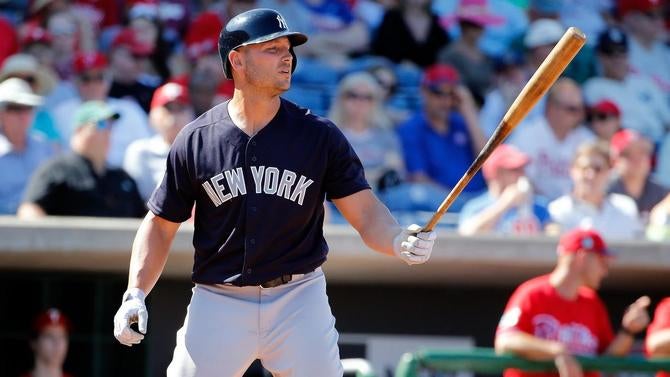
Losing Gregorius has already thrown a wrench into New York’s Opening Day plans. It’s unclear who will take over at shortstop -- my guess is it’ll be a combination of players, meaning the Yankees will cycle through two or three shortstops until Gregorius returns -- but until he does, this figures to be Girardi’s regular lineup:
- LF Brett Gardner
- CF Jacoby Ellsbury
- C Gary Sanchez
- DH Matt Holliday
- 1B Greg Bird
- 2B Starlin Castro
- 3B Chase Headley
- RF Aaron Judge
- Replacement shortstop
Bench: C Austin Romine, 1B Chris Carter, IF Ronald Torreyes, OF Aaron Hicks
The Yankees have discussed breaking up Gardner and Ellsbury atop the lineup, and if they do, Girardi indicated he will bat Sanchez second. Teams are getting away from the old school bat control No. 2 type hitters and are now batting thumpers in that lineup spot. Here was Girardi’s lineup on Tuesday:
3/28 #NYYSpring lineup vs DET:
— New York Yankees (@Yankees) March 28, 2017
Gardner LF
Sanchez C
Bird 1B
Holliday DH
Ellsbury CF
Castro 2B
Headley 3B
Hicks RF
Torreyes SS
Tanaka P
Girardi said tonight's lineup "very well could be similar" to what he puts out on Opening Day
— Erik Boland (@eboland11) March 28, 2017
I have a hard time thinking Ellsbury, who owns a .264/.329/.382 (94 OPS+) batting line in three years with New York, will be dropped any further down the lineup with four years and $85 million left on his contract, but we’ll see. The Yankees did release A-Rod and reduce McCann’s and Teixeira’s playing time late last season to make room for the kids, so maybe they’ll do the something similar with Ellsbury.
If you’re looking for a reason to feel good about New York’s offense this year, it’s Bird and Holliday. They’re replacing Teixeira and A-Rod, who hit a combined .203/.276/.358 with 24 home runs in 681 plate appearances in 2016. It’s hard to think Bird and Holliday will be that bad this year. Also, the Yankees will have a full season of Sanchez.
Probable Rotation
As I mentioned earlier, the Yankees are currently holding a spring training competition for their final two rotation spots, and things are pretty wide open. Severino, Mitchell, Green, and Montgomery are all still in camp with a chance to start. Here’s the projected rotation:
- RHP Masahiro Tanaka
- LHP CC Sabathia
- RHP Michael Pineda
- TBA
- TBA
There is some big time volatility in this rotation. Tanaka’s elbow issue is in the back of everyone’s mind. Sabathia had a fine 2016 season, but he’s also 36 and very clearly in decline. Pineda is an enigma. He’ll strike out 12 one start and get knocked out in the second inning the next. The kids? Who knows. If the Yankees do not make it to the postseason for the fourth time in five years in 2017, chances are we’ll be able to point to the rotation as the reason why.
Probable Bullpen
The Yankees spent a lot of money to bring Chapman back to ensure the back of their bullpen was strong. Chapman and Betances are arguably the best closer-setup man tandem in baseball. Whenever the Yankees have a lead after seven innings -- or even six innings given Betances’ ability to throw multiple innings -- they have a pretty good chance to win. Here is Girardi’s projected relief crew:
- Closer: LHP Aroldis Chapman
- Setup: RHP Dellin Betances
- Middle: RHP Tyler Clippard, RHP Adam Warren, LHP Tommy Layne
- Long: TBA, TBA
The Yankees are very aggressive with the last spot or two in the bullpen. They’ll send pitchers down and call someone up to make sure they always have a fresh long man available, and there’s no reason to think they won’t do the same thing this year. All the rotation candidates (Severino, Cessa, Mitchell, Green, Montgomery) are bullpen candidates, as are relievers like Heller, Holder, Ernesto Frieri, Johnny Barbato, and Chasen Shreve. Veteran Jonathon Niese is also in camp trying to win a bullpen job.
Those last two spots are up for grabs and they’ll probably be a revolving door all season. The core of the bullpen is Chapman and Betances, with Clippard and Warren representing rock-solid third and fourth options. The odds are against the Yankees getting a lot of innings from their rotation, so they’ll need their bullpen to absorb a large workload throughout the summer.














